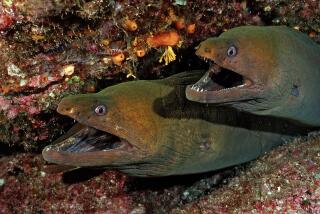Reports Resurface of Stray Whale in Bay
Reports of the whale in the bay began Sunday morning, when passing boaters told Coast Guard officers a whale was off Point Loma, said Lt. Gilbert Flores. By Sunday evening, reports had the whale heading into San Diego Bay, and near the Coast Guard station east of Harbor Island.
Although no sightings were reported Monday or Tuesday, the mammal--apparently a gray whale, its size uncertain--was spotted Wednesday in the harbor by several boaters and by sailors aboard the Navy minsweeper Constant who saw the creature near Harbor Island.
The last sighting was about 11:30 a.m. Wednesday, when the whale was seen about 200 yards off Harbor Island.
There was no way of knowing whether the whale spotted on Sunday and the one seen Wednesday are the same creature, Flores said. He also said there were no reports that it was being harassed or that it had hit any boats.
But he was concerned that the whale, should it venture too far south into the bay, may have a hard time finding its way back out.
Dan LeBlanc, a spokesman for Sea World, said the marine park has been informed of the sightings, but the reports indicated that the animal was not in distress.
“It’s not unusual to have a whale in the harbor,” LeBlanc said. “It usually happens at least once a year. They like to poke around in the nooks and crannies.”
Because the whale does not appear to be in trouble, and is not a hazard to navigation, officials plan no action at the moment.
Gray whales are endangered species, and, as such, boats are forbidden from approaching within 100 yards of them. The National Marine Fisheries Service, an arm of the National Oceanic and Atmospheric Administration, is charged with overseeing and administrating marine mammal protection laws.
“Sometimes the young like to hang out in the kelp beds,” said Joe Cordaro, a wildlife biologist for the federal agency. “Once in a while, (whales) like to stray. God only knows why.”
The whales, he said, are now migrating north after calving in Baja California.
Each year, beginning in mid-November, the whales migrate south from Alaska to Baja California to calve and breed, most notably in Scammon’s Lagoon, Cordaro said. The return journey north usually occurs this time of year, in late March and early April, Cordaro said.
“Usually the males, the non-breeding females, and the older calves migrate first,” Cordaro said. “The last to leave are the cows that have just given birth and the newborn calves.”
Cordaro said he did not know whether the whale in San Diego Harbor is a newborn or an older whale.
April is the peek migration period, Cordaro said. The whales are heading toward the Bering and Chukchi seas, where they will feed until the fall, when they begin their southward migration once again.
More to Read
Sign up for Essential California
The most important California stories and recommendations in your inbox every morning.
You may occasionally receive promotional content from the Los Angeles Times.









